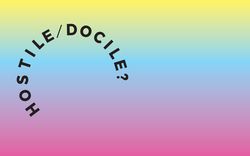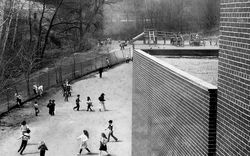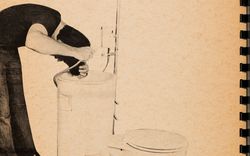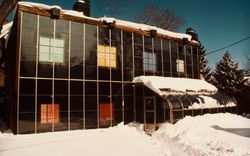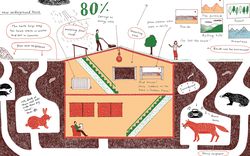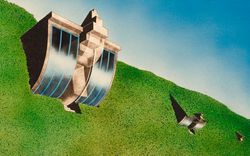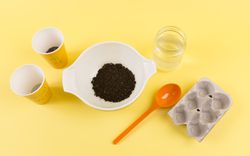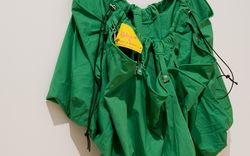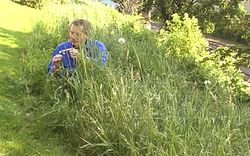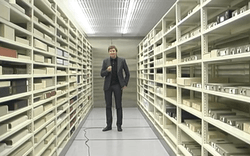The Kelbaugh House
Text by Pierre-Édouard Latouche
Douglas Kelbaugh acknowledges he was unfamiliar with solar architecture in 1973 when he started designing his home in Princeton, New Jersey.1 Then a recent graduate of Princeton University’s School of Architecture, Kelbaugh discovered solar as an option when he saw a schematic section of a Trombe wall in a European design magazine. Impressed by the astonishing simplicity of the system, he decided to adapt it to local conditions.
The lot Kelbaugh owned was mostly shaded, so he built the house on the only sunny portion, the northeast corner, with a footprint of 92 square metres. To achieve 195 square metres of space meant building a two-storey structure, and consequently the equivalent of two Trombe walls, one on top of the other, which had never been done before. Construction began in 1974.
-
Author’s conversation with Douglas Kelbaugh, Ann Arbor, Michigan, April 2007. ↩
Built of poured concrete and painted with a black selective coating, the Trombe wall has a surface area of 56 square metres and is 38 centimetres thick. It is penetrated by six windows and an opening giving access to the greenhouse, which is attached to the double-glazed curtain-wall covering the south facade. The Trombe wall follows architect Jacques Michel’s model that provides heating in winter and cooling in summer. The well-insulated, wood-frame house is essentially a lean-to, supported by the thick concrete wall. An admirer of Le Corbusier, Kelbaugh included references to his work in this house, such as bright colours for the interior shutters, cedar plywood siding, and niches/shelves cast into the inside of the Trombe wall.
During its first winter, 1975–76, the passive heating system produced large-scale energy savings. However, several major problems lowered overall performance: reverse convection at night, night-time heat loss through the large opening into the colder greenhouse, and heat rising to the second floor via the open stairwell, as shown by a series of readings taken by Douglas Balcomb of the Los Alamos laboratory in December 1977. Measurement devices located downstairs, upstairs, and in the greenhouse recorded that the indoor temperature remained relatively stable, with a daily swing between 13 and 24 degrees Celsius and an average of about 17 degrees Celsius, while the outside temperature ranged widely, from -13 to 14 degrees Celsius.1 Modifications over several years gradually solved or minimized these problems.
-
Douglas Kelbaugh, “Kelbaugh House: Recent Performance,” in Proceedings of the 2nd National Passive Solar Conference (Newark, Delaware: American Section of the International Solar Energy Society, 1978), 69–75. ↩
The origin of the Kelbaugh House concept, and the various problems and adjustments that marked its first years of occupancy, illustrate the experimental nature of solar houses built in the wake of the 1973 oil crisis. Despite many twentieth-century precedents, solar building was still largely unexplored terrain. Douglas Kelbaugh expanded on his experience, founding Kelbaugh & Lee in 1978. The firm realized some twenty projects during its lifespan (until 1985), and won fifteen design awards, including an American Institute of Architects National Honor Award for the Roosevelt Solar Village in New Jersey.
This text and its accompanying illustrations were first published in our 2007 book Sorry, Out of Gas. The letter and fact sheet at the top of the page come from the Douglas Kelbaugh fonds, which includes material and other documentation related to over twenty of Kelbaugh & Lee’s projects.

